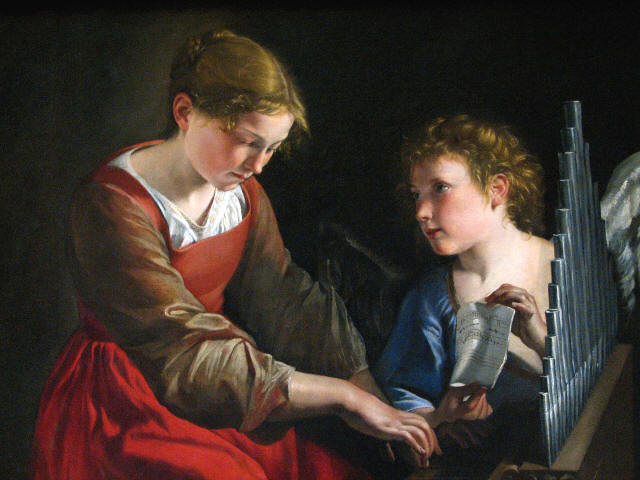Saint Cecilia
Patron Saint of Music
22 November
 Poets
praise her as the patron of music and musicians, Christians in the
Catholic tradition revere her for her harrowing martyrdom,
and one of Rome's loveliest churches, Santa Cecilia in Trastevere, is dedicated
to her. Built over the site where her house once stood, the church contains her
tomb, marked by an exquisite statue. But St. Cecilia hasn't always rested in
peace--her body has been buried, exhumed, moved and re-buried at least three
times. Cecilia herself is a haunting, almost fairy-tale figure whose story is a
marvellous Roman mix of facts and fables, religion and romance.
Poets
praise her as the patron of music and musicians, Christians in the
Catholic tradition revere her for her harrowing martyrdom,
and one of Rome's loveliest churches, Santa Cecilia in Trastevere, is dedicated
to her. Built over the site where her house once stood, the church contains her
tomb, marked by an exquisite statue. But St. Cecilia hasn't always rested in
peace--her body has been buried, exhumed, moved and re-buried at least three
times. Cecilia herself is a haunting, almost fairy-tale figure whose story is a
marvellous Roman mix of facts and fables, religion and romance.
The popularity of St. Cecilia has kept
her on the calendar of the saints, although nothing certain is known about her.
Legends say that she was the daughter of patrician Roman Christians and had
dedicated herself to God while she was young. She was married to Valerian, who
converted when saw his bride conversing with an angel. His brother Tiburtius
also saw the angel and converted. The brothers, with a man named Maximus, buried
martyrs, and the three were caught, tried, and martyred. In some tales, Cecilia
is with them at the time of their arrest; in others, she is caught burying the
three men. Sentenced to be suffocated in her own bathroom, Cecilia survived. An
attempt to behead her wounded her mortally. She is said to have asked
Urban I to make her house into a
church. She died three days after the sword failed to behead her.
A woman named Cecilia, or something
similar to it, founded a church in the Trastevere quarter of Rome; her body was
buried in a place of honour in the catacombs of Calixitus, whence
Paschal I translated them to the
church of St. Cecilia. When the tomb was opened in 1599, the body was said to be
incorrupt (it later disintegrated), and Madera sculpted a life-sized statue of
her, which is now in the catacombs.
|
St. Cecilia is the patron saint of music and
depictions of her are usually found in the
choir lofts of churches. Depending on the source, the association with
music either stems from the story that Cecilia heard music during her
wedding; or she praised God as she was dying a martyr's death, singing
to Him. In paintings—most
famously in a portrait by Raphael - she is often shown at the organ. In
literature, St. Cecilia is the subject of the Second Nun's Tale in the
Canterbury Tales, of John Dryden's “A Song for St. Cecilia's Day,
1687,” and of Alexander Pope's “Ode for Music on St. Cecilia's Day.”
Dryden's song was set to music by Handel. Her feast day is Nov. 22. |
Blessed Cecilia, appear in visions To all musicians, appear and inspire: Translated Daughter, come down and startle Composing mortals with immortal fire. W. H. Auden, Hymn to St. Cecilia |
Acknowledgements:
Text adapted from
Ecoleweb,
Infoplease,
Flicker,
Why
Cecilia?,
Image from
Pbase